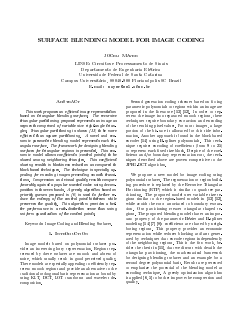
Surface Blending Model for Image Coding
Joceli Mayer
DOI: 10.14209/sbrt.2001.01400033
Evento: XIX Simpósio Brasileiro de Telecomunicações (SBrT2001)
Keywords: Image Coding and Blending Surfaces
Abstract
"This work proposes an efficient image representation based on triangular blending surfaces. The recursive triangular partitioning proposed represents an image as segments comprised of variable size right-angle triangles. Triangular partitioning is shown [11] to be more efficient than square partitioning. A novel and economic parametric blending model represents each triangular surface. The framework for designing blending surfaces for triangular regions is presented. This economic model allows coefficients (control points) to be shared among neighboring triangles. This coefficient sharing results in blockiness reduction as compared to block based techniques. The technique is specially appealing for encoding images presenting smooth transitions. Compression and visual quality results compare favorably against a popular wavelet codec using decomposition into seven bands. A greedy algorithm based on priority queues proposed in [6] is used to further reduce the entropy of the control point bitstream while preserves the quality. This algorithm provides a bet- ter performance in a rate-distortion sense than using uniform quantization of the control points."Download